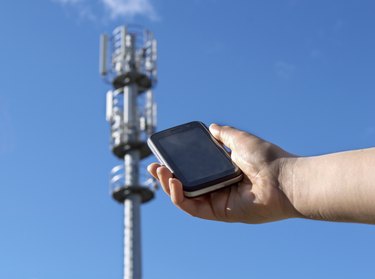
Cell phones use technology that has existed for many years, but was not applied to mobile communication until the 1980s. Modern cell phones are notable because of their mobility. Users can carry on conversations with each other, both talking at the same time and moving in different directions, because of the way the cell phone sends and receives signals from nearby cell phone towers.
Cell Phones
Video of the Day

Cell phones are actually radios. They operate in ways very similar to walkie-talkies, with several key differences. Walkie-talkies use a single radio signal on one channel to talk over a short distance. Cell phones use multiple frequencies so that two users can talk at the same and have expansion technology that allows them to be used at very long distances. The basic technology, however, including transmitters and receivers, remains the same.
Video of the Day
Frequencies

Cell phones use radio frequencies to send and receive information that is translated into sound. At any given time while in use, the cell phone is sending information on at least two different frequencies, one for sending information and one for receiving it. There is a certain band of frequencies that have been set aside specifically for cell phone service providers to use for this purpose. Unlike a walkie-talkie, the user does not have control over the frequency they are using.
Cell Signals

Cell phones do not just send signals to each other--although many have that capability. Instead, most send their signals to cell phone towers. These towers take the signal, amplify it and send it to another tower within their range, usually several miles away. These towers can bounce the signal from tower to tower until it comes in range of the other caller so the signal can be sent to their phone. These towers are built in large grids, or cells--hence the name "cell" phone--and are designed to automatically switch the signal from tower to tower as the users move through the grid.
Digital Signals

In the beginning, cell phones used two whole frequencies for conversations. However, as the number of cell phone users grew, the cell providers realized they would soon run out of frequencies, so digital signals were introduced. These signals encode sound data in binary and send the data in packets, using multiple frequencies at once. The packets are decoded and turned back into sound by the receiving cell phone. This allows companies to save frequency space and time.
Coverage Areas

Each cell provider has a certain coverage area, or a grid of cell phone towers that have their equipment, so they can relay cell signals. If a user steps outside this grid, the phone will either not work or go into roaming, trying to use other equipment from different companies instead of the original technology it was designed for. This is one reason roaming is more expensive than regular cell phone coverage fees.